Abstract
Over the past few decades, there have been major technological improvements in the manufacture of intravenous solutions and the manufacture and design of catheter materials. However, the risk of infection in patients receiving infusion therapy remains substantial, in part because of host factors (for example, increased use of immunosuppressive therapy, more aggressive surgery and life support, and improved survival at the extremes of life) and in part because of the availability of catheters that can be left in place for very long periods. Microbial components of normal skin flora, particularly coagulase-negative staphylococci, have emerged as the predominant pathogens in catheter-associated infections. Therefore, efforts to prevent skin microorganisms from entering the catheter wound (such as tunnelling of catheters and use of catheter cuffs and local antimicrobial agents) are logical and relatively effective. The specific properties of microorganisms that transform normally harmless commensals such as coagulase-negative staphylococci into formidable pathogens in the presence of a plastic foreign body are being explored. For example, Staphylococcus epidermidis elaborates a polysaccharide adhesin that also functions as a capsule and is a target for opsonic killing. However, the interactions between microorganism and catheter that lead to adherence, persistence, infection, and dissemination appear to be multifactorial.
Full text
PDF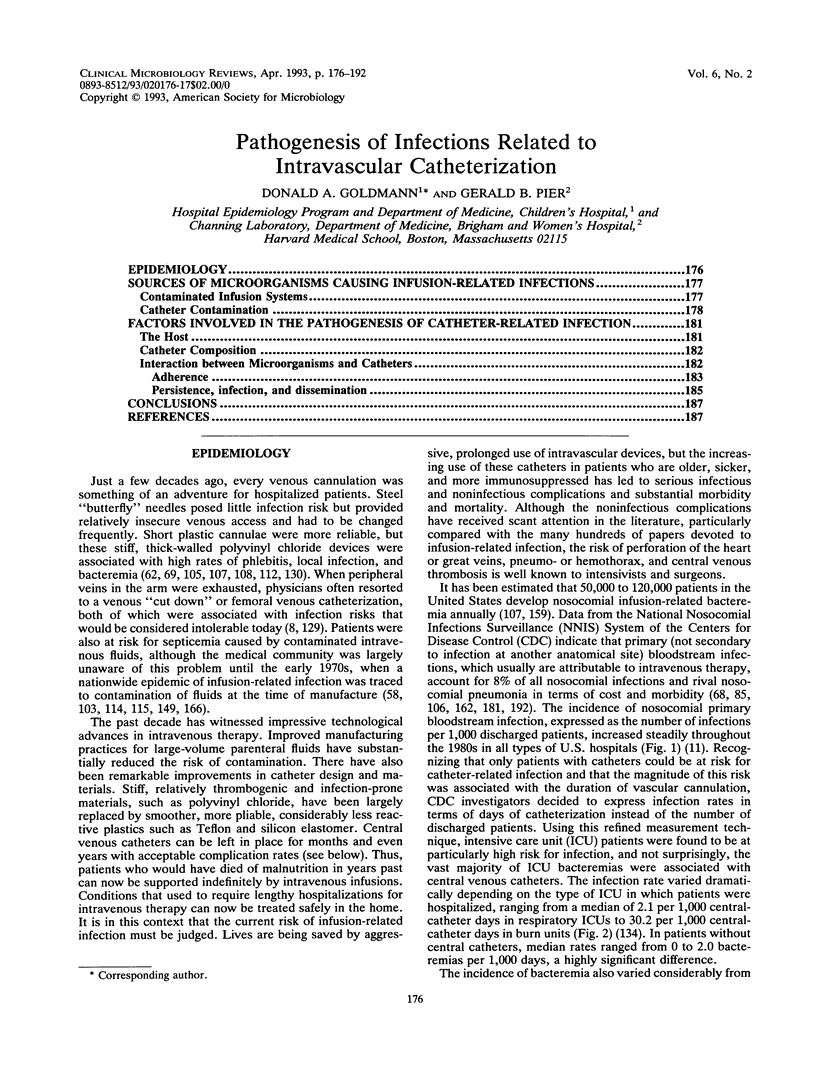
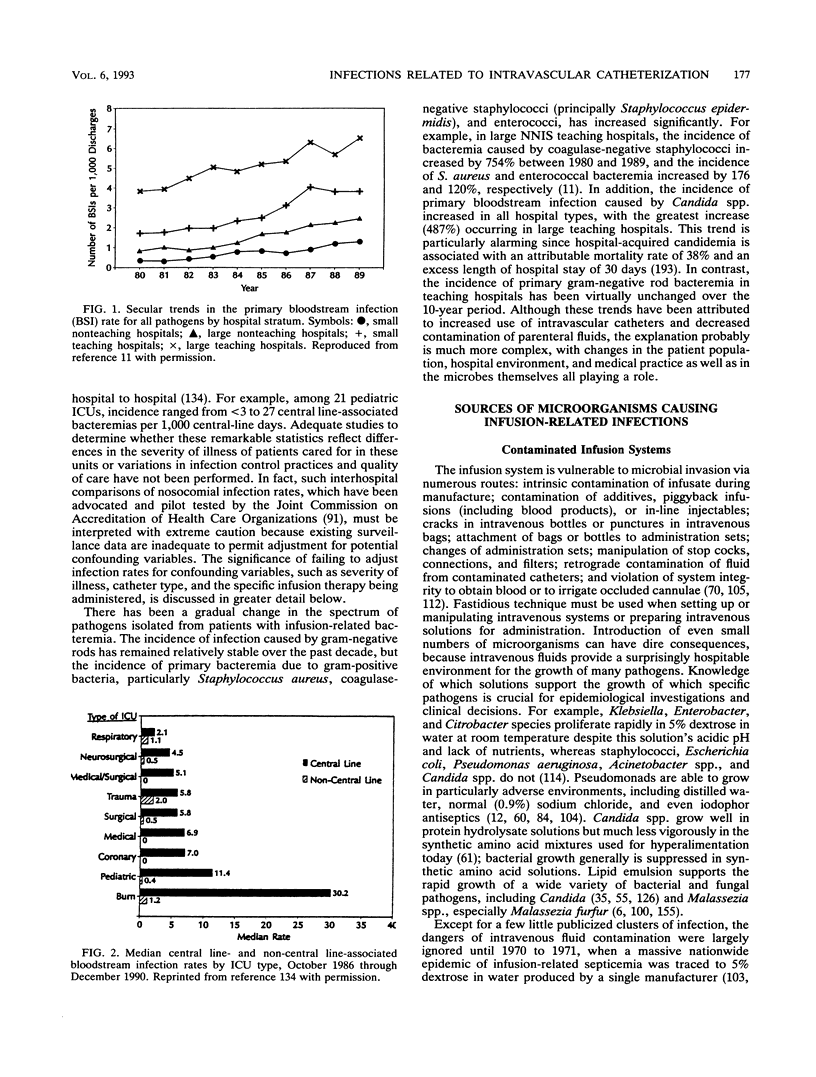
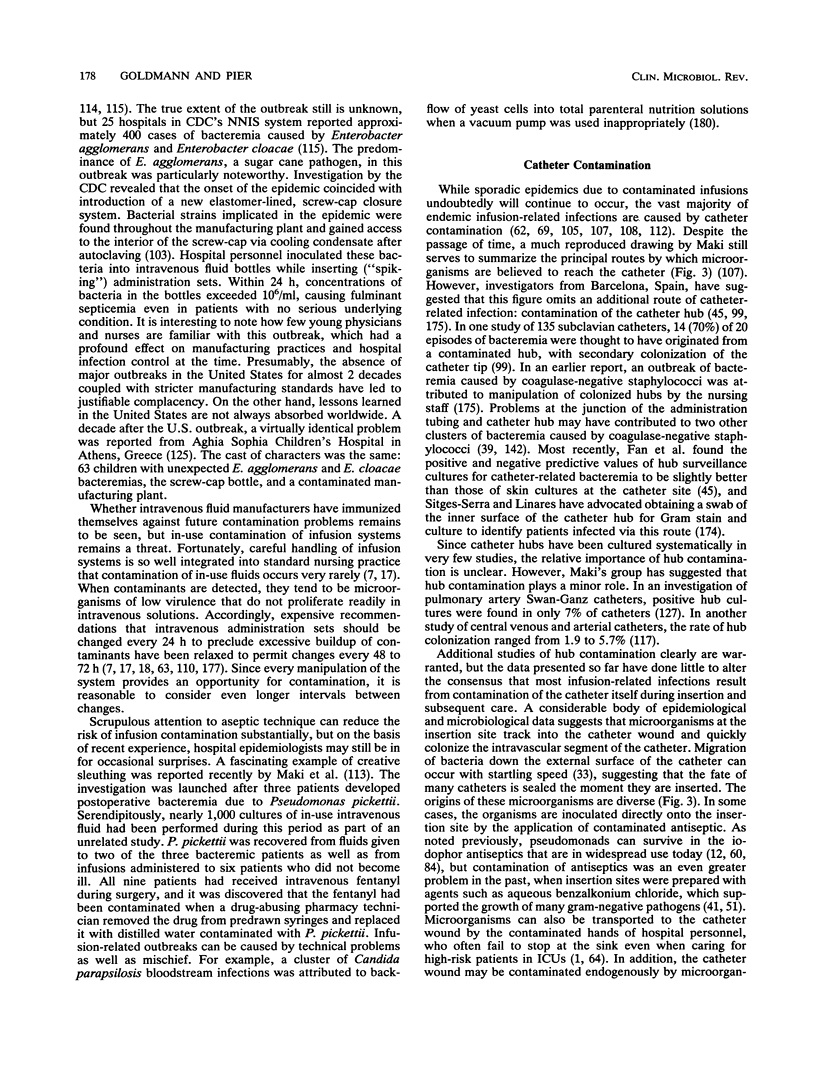
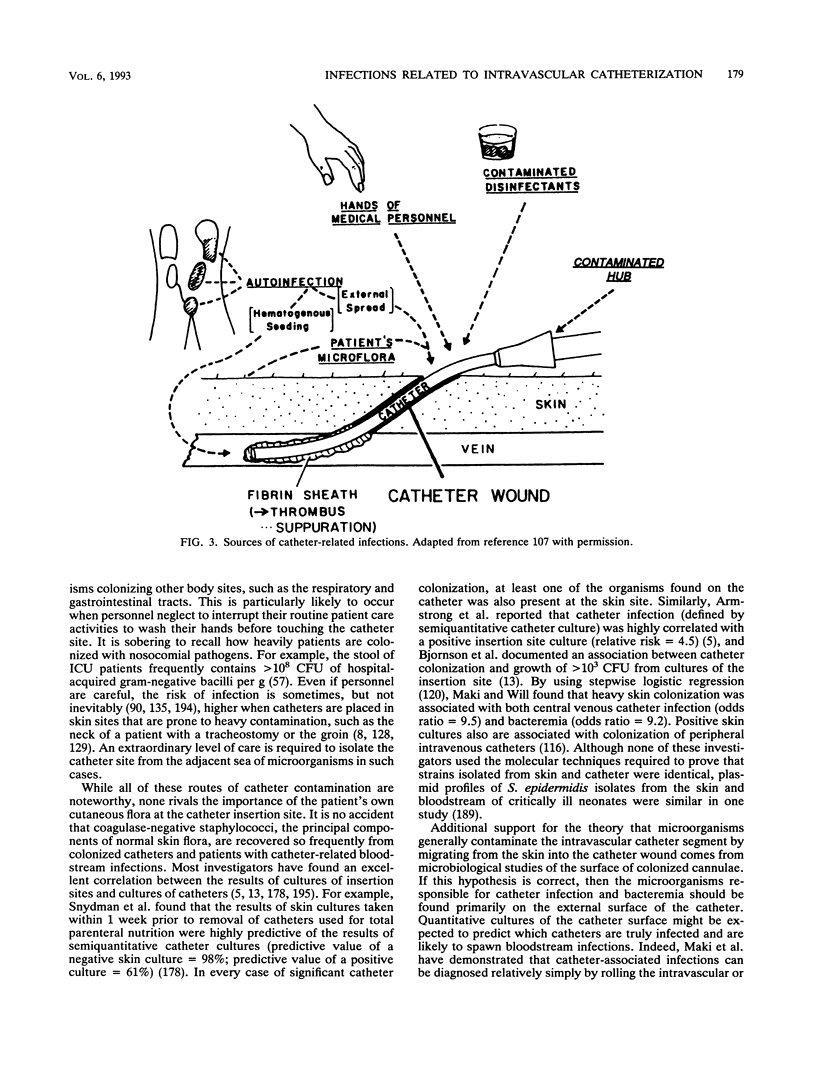
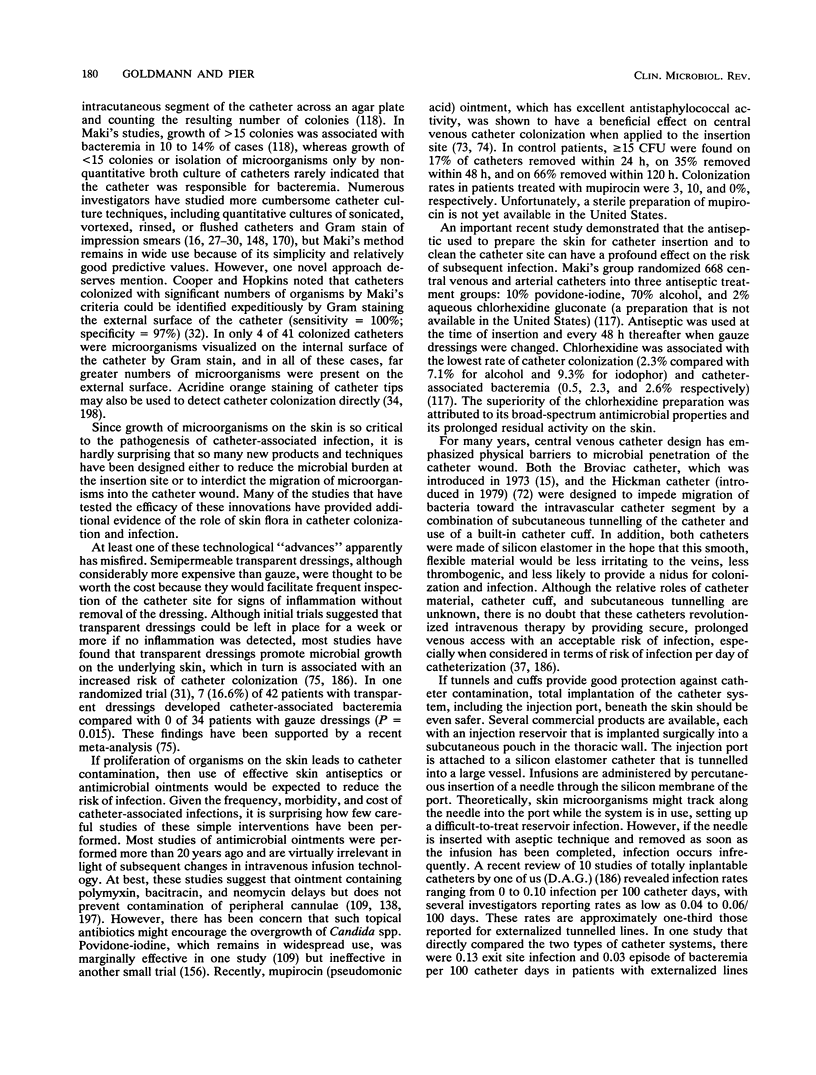

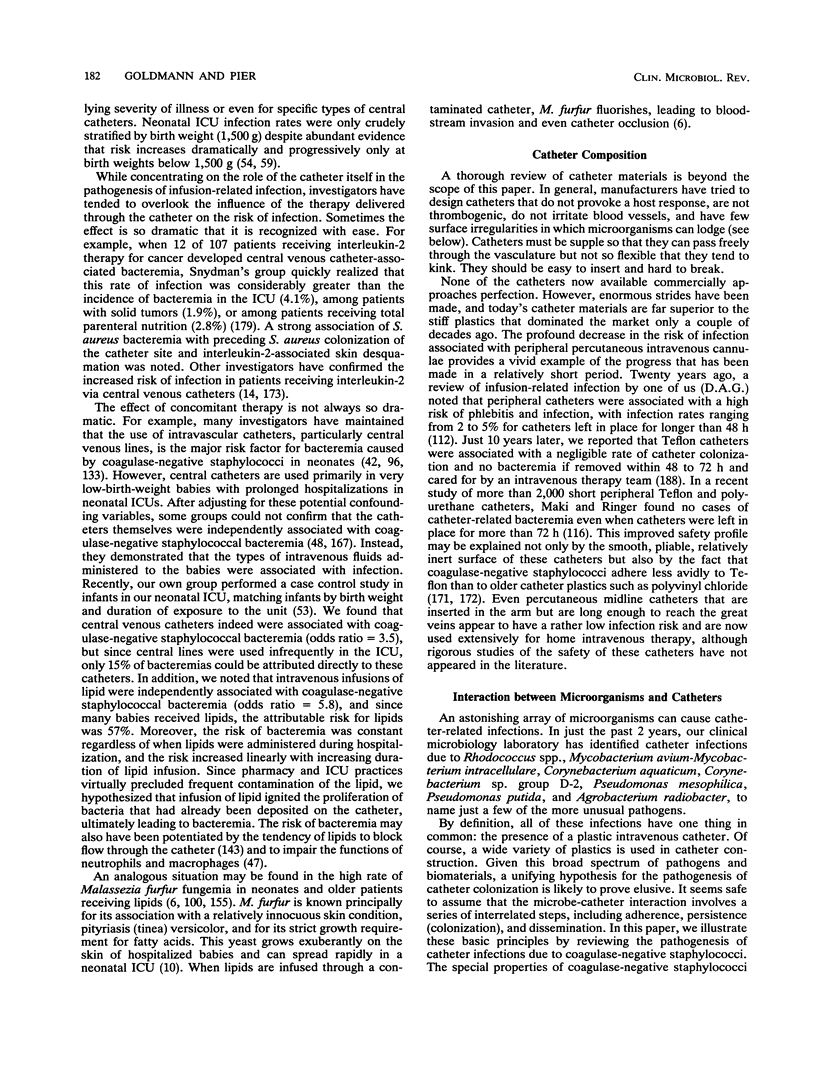
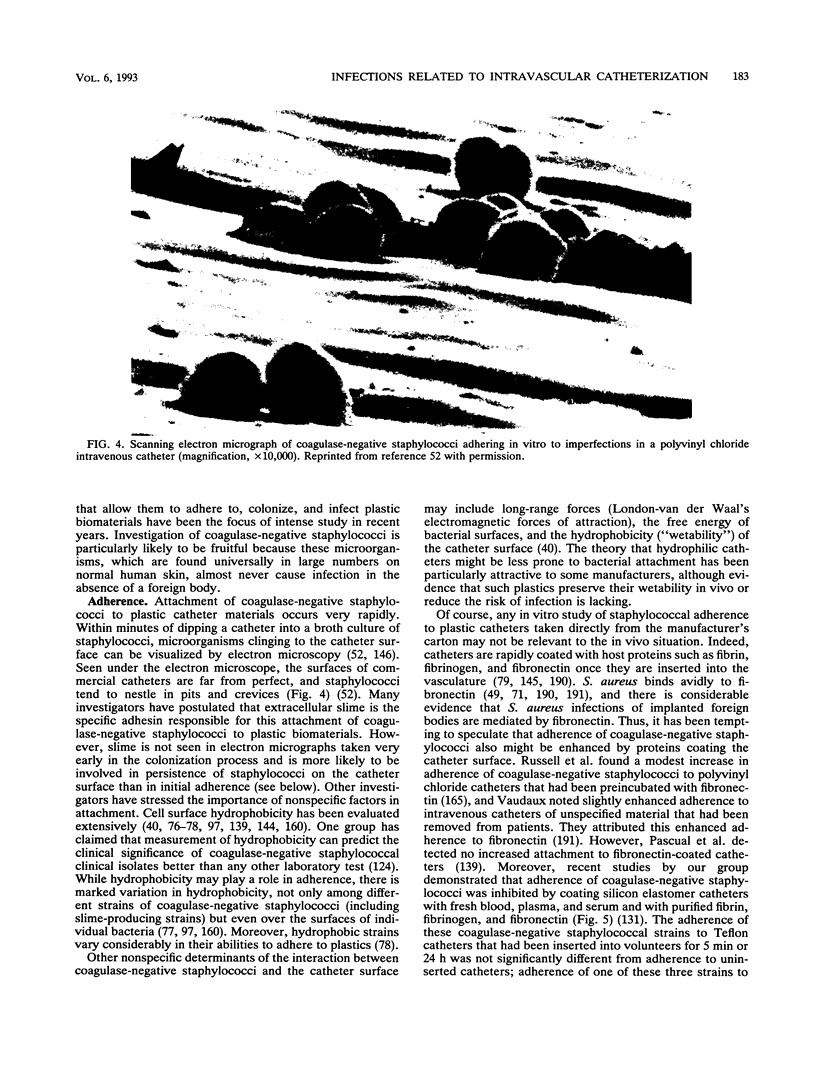
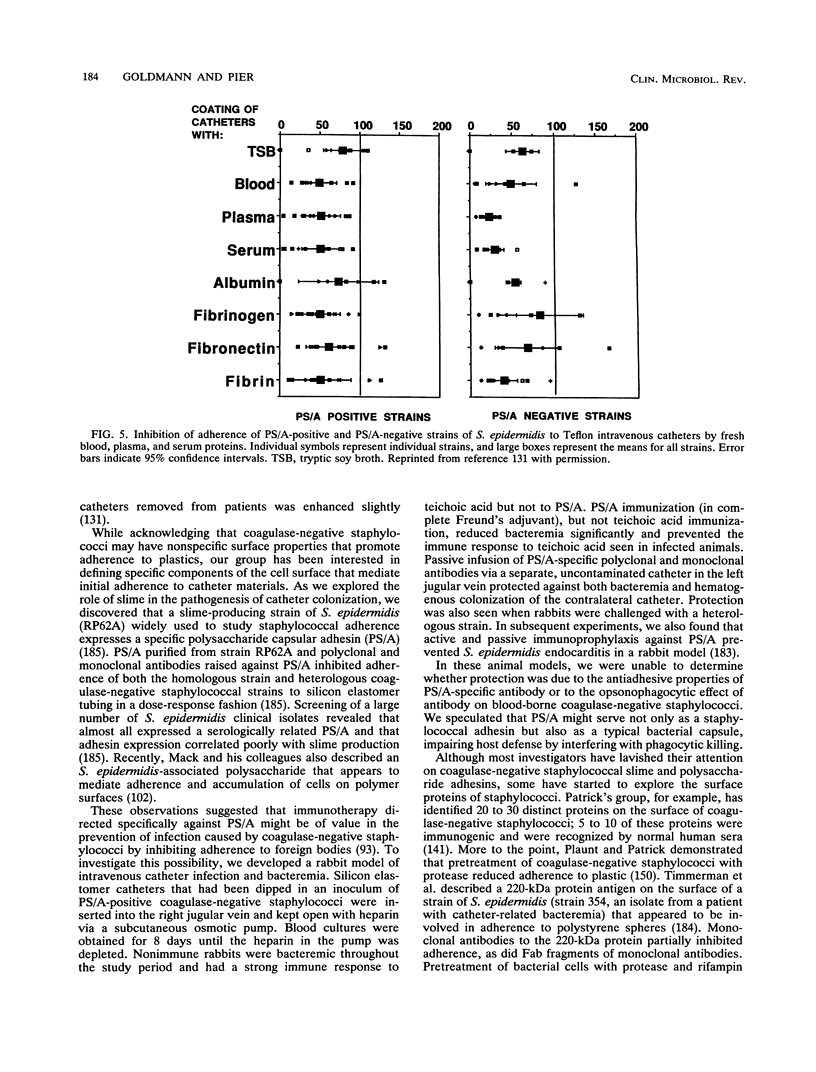
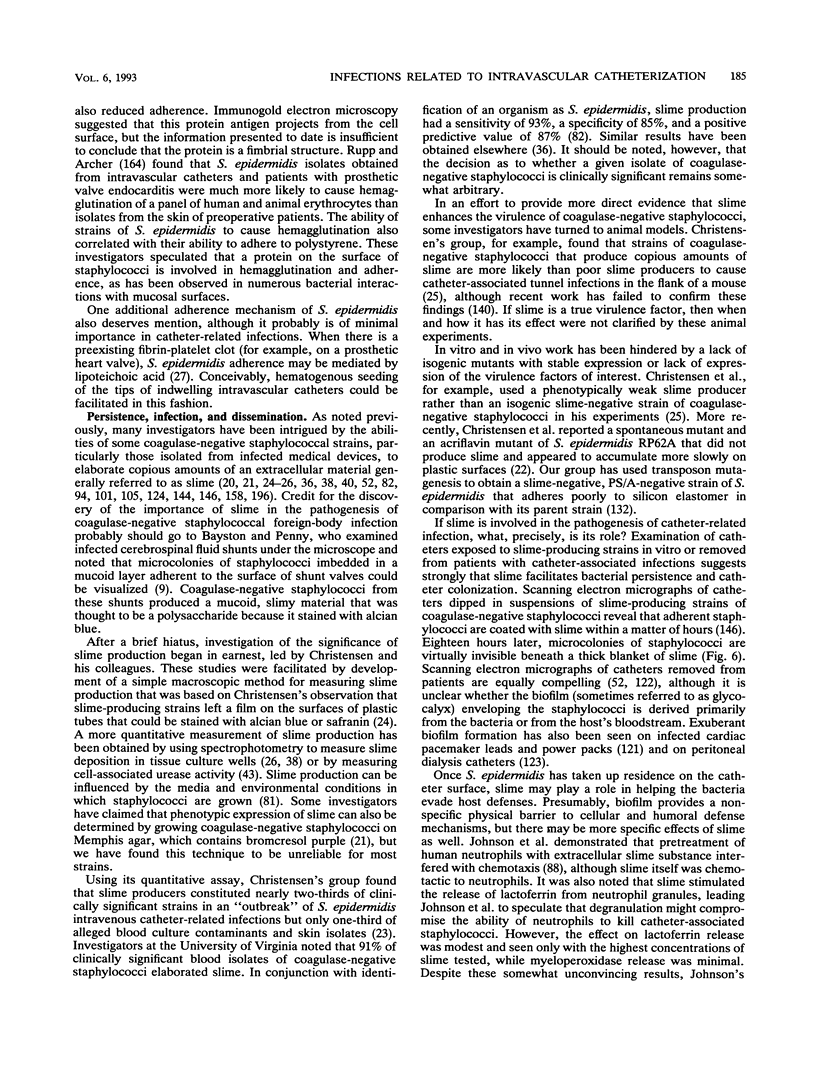
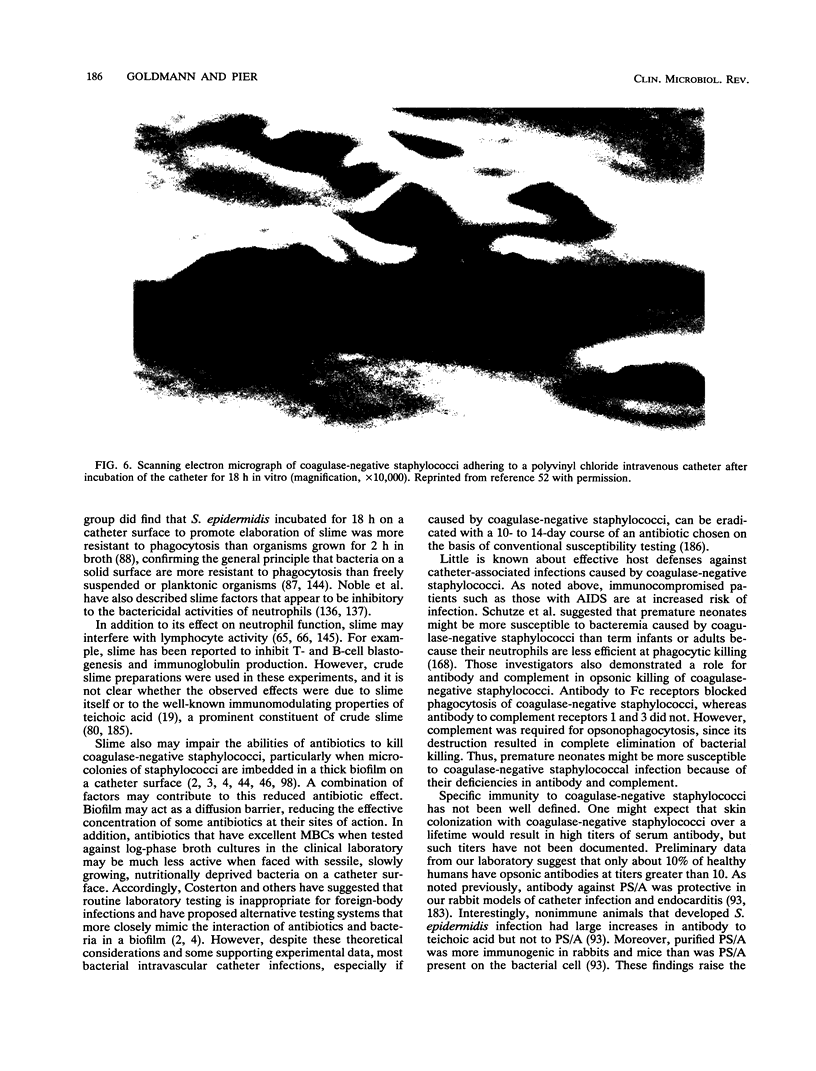
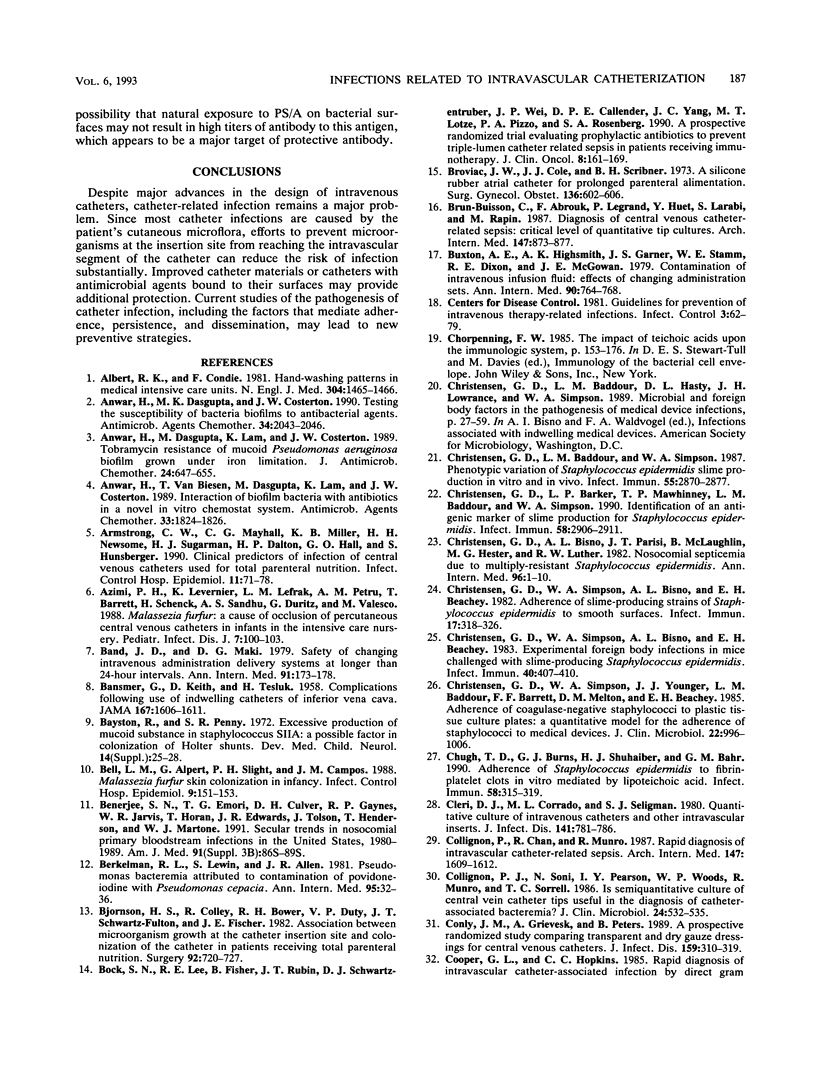
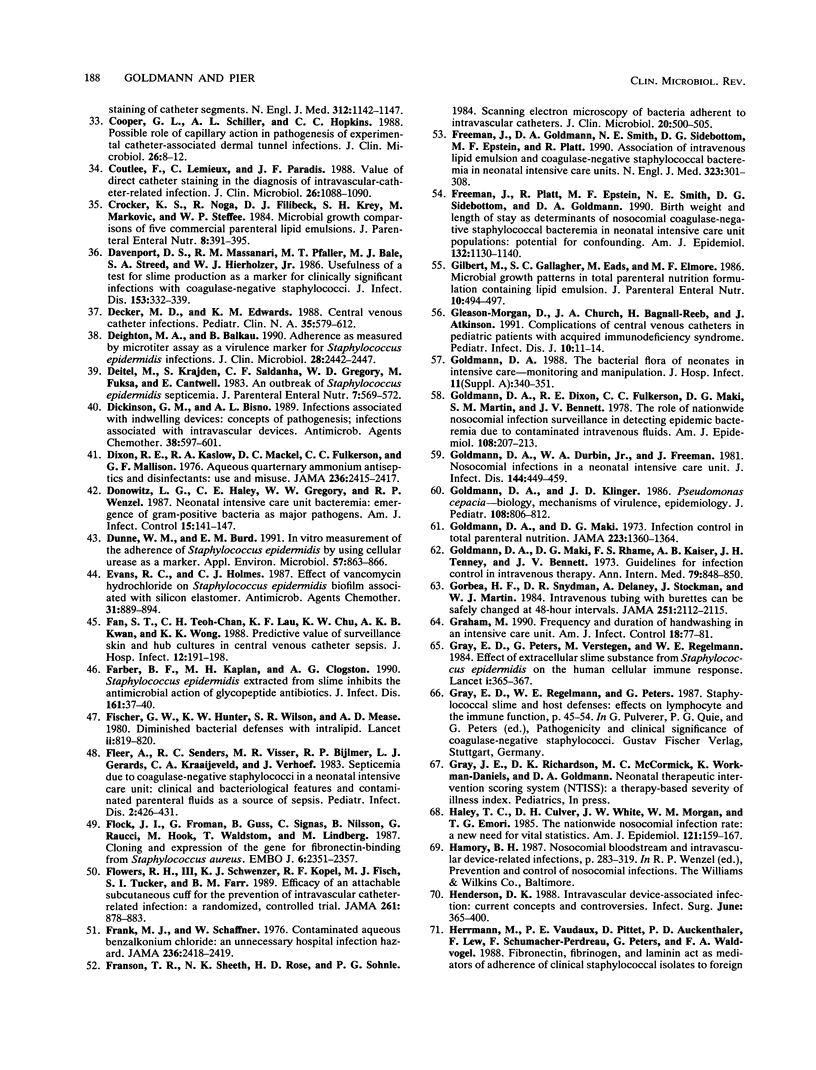
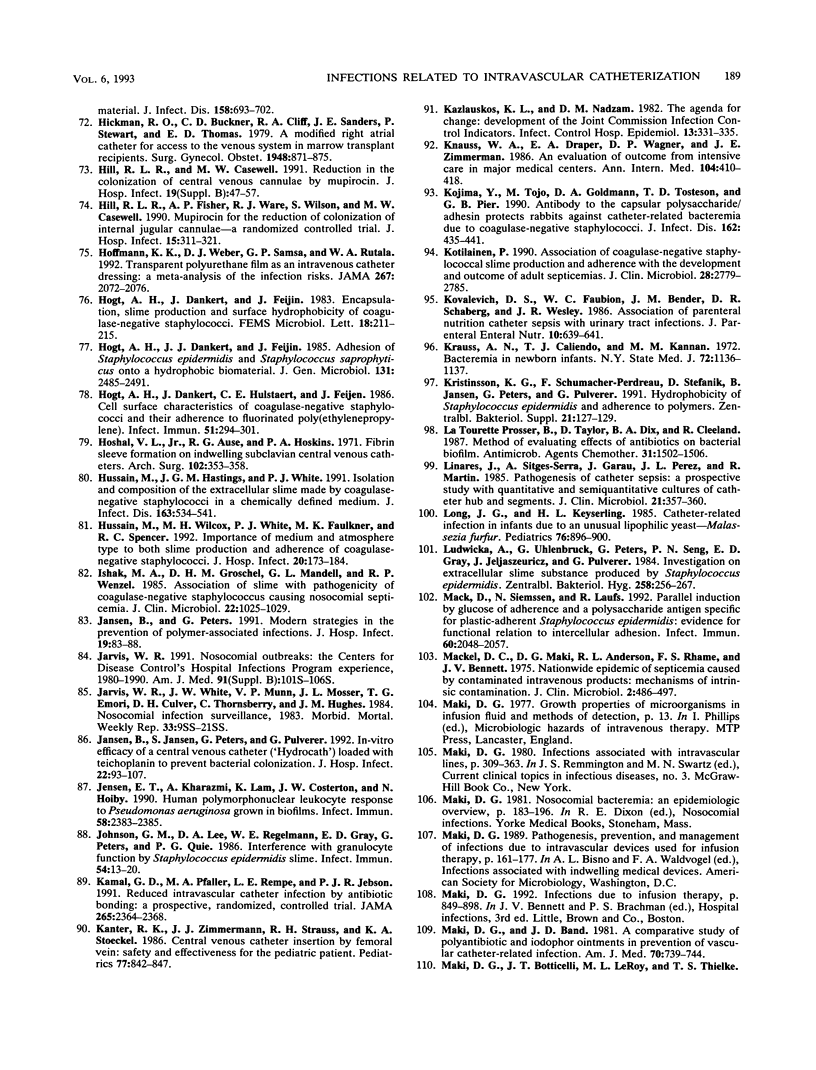
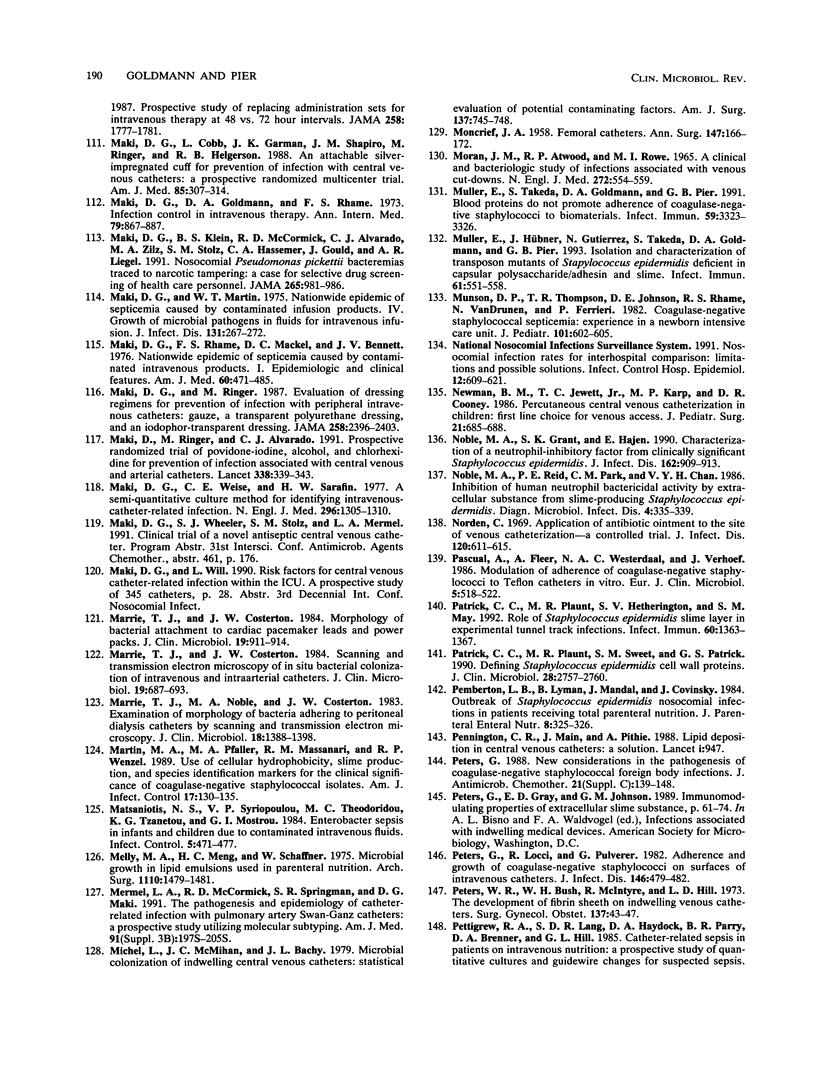
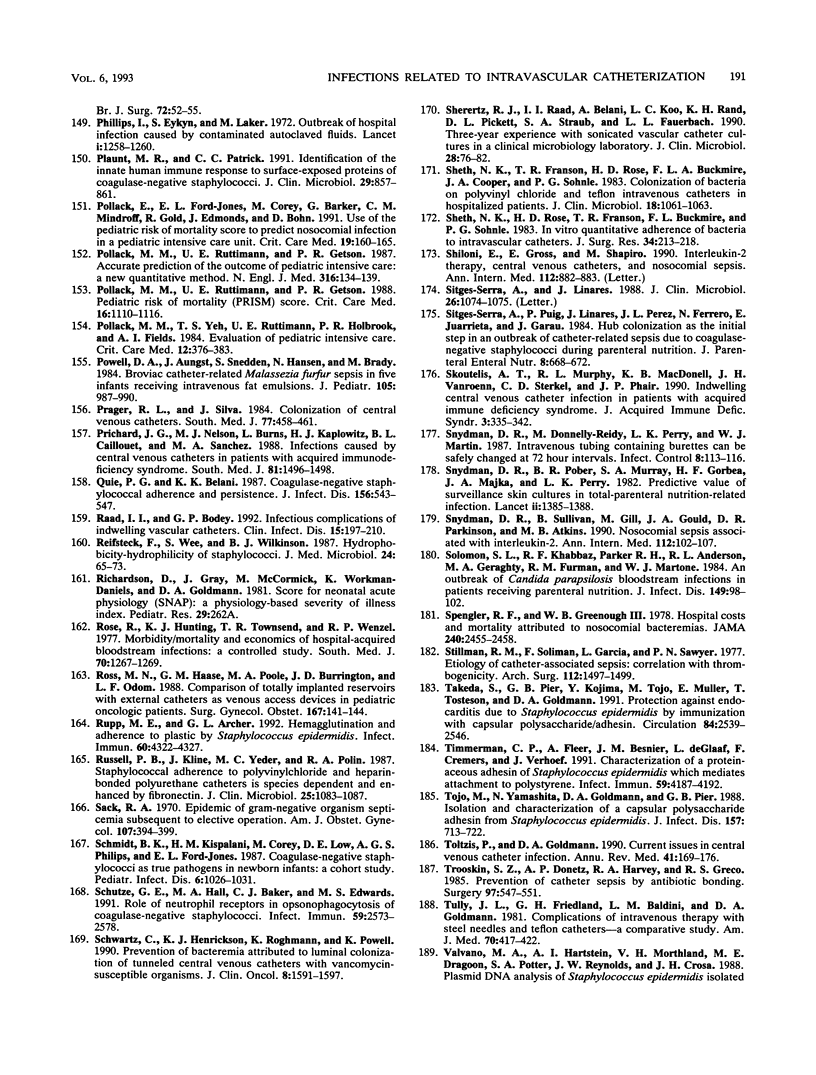
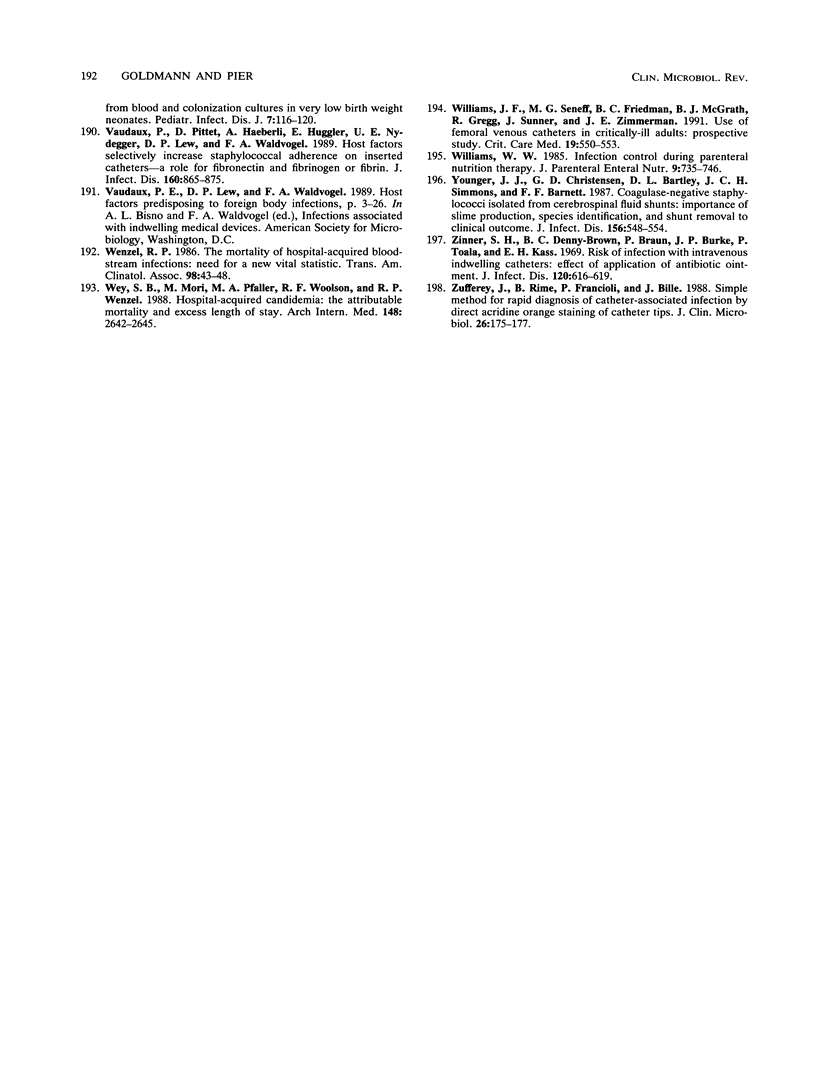
Images in this article
Selected References
These references are in PubMed. This may not be the complete list of references from this article.
- Albert R. K., Condie F. Hand-washing patterns in medical intensive-care units. N Engl J Med. 1981 Jun 11;304(24):1465–1466. doi: 10.1056/NEJM198106113042404. [DOI] [PubMed] [Google Scholar]
- Anwar H., Dasgupta M. K., Costerton J. W. Testing the susceptibility of bacteria in biofilms to antibacterial agents. Antimicrob Agents Chemother. 1990 Nov;34(11):2043–2046. doi: 10.1128/aac.34.11.2043. [DOI] [PMC free article] [PubMed] [Google Scholar]
- Anwar H., Dasgupta M., Lam K., Costerton J. W. Tobramycin resistance of mucoid Pseudomonas aeruginosa biofilm grown under iron limitation. J Antimicrob Chemother. 1989 Nov;24(5):647–655. doi: 10.1093/jac/24.5.647. [DOI] [PubMed] [Google Scholar]
- Anwar H., van Biesen T., Dasgupta M., Lam K., Costerton J. W. Interaction of biofilm bacteria with antibiotics in a novel in vitro chemostat system. Antimicrob Agents Chemother. 1989 Oct;33(10):1824–1826. doi: 10.1128/aac.33.10.1824. [DOI] [PMC free article] [PubMed] [Google Scholar]
- Armstrong C. W., Mayhall C. G., Miller K. B., Newsome H. H., Jr, Sugerman H. J., Dalton H. P., Hall G. O., Hunsberger S. Clinical predictors of infection of central venous catheters used for total parenteral nutrition. Infect Control Hosp Epidemiol. 1990 Feb;11(2):71–78. doi: 10.1086/646125. [DOI] [PubMed] [Google Scholar]
- Azimi P. H., Levernier K., Lefrak L. M., Petru A. M., Barrett T., Schenck H., Sandhu A. S., Duritz G., Valesco M. Malassezia furfur: a cause of occlusion of percutaneous central venous catheters in infants in the intensive care nursery. Pediatr Infect Dis J. 1988 Feb;7(2):100–103. [PubMed] [Google Scholar]
- BANSMER G., KEITH D., TESLUK H. Complications following use of indwelling catheters of inferior vena cava. J Am Med Assoc. 1958 Jul 26;167(13):1606–1611. doi: 10.1001/jama.1958.02990300032007. [DOI] [PubMed] [Google Scholar]
- Band J. D., Maki D. G. Safety of changing intravenous delivery systems at longer than 24-hour intervals. Ann Intern Med. 1979 Aug;91(2):173–178. doi: 10.7326/0003-4819-91-2-173. [DOI] [PubMed] [Google Scholar]
- Banerjee S. N., Emori T. G., Culver D. H., Gaynes R. P., Jarvis W. R., Horan T., Edwards J. R., Tolson J., Henderson T., Martone W. J. Secular trends in nosocomial primary bloodstream infections in the United States, 1980-1989. National Nosocomial Infections Surveillance System. Am J Med. 1991 Sep 16;91(3B):86S–89S. doi: 10.1016/0002-9343(91)90349-3. [DOI] [PubMed] [Google Scholar]
- Bayston R., Penny S. R. Excessive production of mucoid substance in staphylococcus SIIA: a possible factor in colonisation of Holter shunts. Dev Med Child Neurol Suppl. 1972;27:25–28. doi: 10.1111/j.1469-8749.1972.tb09769.x. [DOI] [PubMed] [Google Scholar]
- Bell L. M., Alpert G., Slight P. H., Campos J. M. Malassezia furfur skin colonization in infancy. Infect Control Hosp Epidemiol. 1988 Apr;9(4):151–153. doi: 10.1086/645819. [DOI] [PubMed] [Google Scholar]
- Berkelman R. L., Lewin S., Allen J. R., Anderson R. L., Budnick L. D., Shapiro S., Friedman S. M., Nicholas P., Holzman R. S., Haley R. W. Pseudobacteremia attributed to contamination of povidone-iodine with Pseudomonas cepacia. Ann Intern Med. 1981 Jul;95(1):32–36. doi: 10.7326/0003-4819-95-1-32. [DOI] [PubMed] [Google Scholar]
- Bjornson H. S., Colley R., Bower R. H., Duty V. P., Schwartz-Fulton J. T., Fischer J. E. Association between microorganism growth at the catheter insertion site and colonization of the catheter in patients receiving total parenteral nutrition. Surgery. 1982 Oct;92(4):720–727. [PubMed] [Google Scholar]
- Bock S. N., Lee R. E., Fisher B., Rubin J. T., Schwartzentruber D. J., Wei J. P., Callender D. P., Yang J. C., Lotze M. T., Pizzo P. A. A prospective randomized trial evaluating prophylactic antibiotics to prevent triple-lumen catheter-related sepsis in patients treated with immunotherapy. J Clin Oncol. 1990 Jan;8(1):161–169. doi: 10.1200/JCO.1990.8.1.161. [DOI] [PubMed] [Google Scholar]
- Broviac J. W., Cole J. J., Scribner B. H. A silicone rubber atrial catheter for prolonged parenteral alimentation. Surg Gynecol Obstet. 1973 Apr;136(4):602–606. [PubMed] [Google Scholar]
- Brun-Buisson C., Abrouk F., Legrand P., Huet Y., Larabi S., Rapin M. Diagnosis of central venous catheter-related sepsis. Critical level of quantitative tip cultures. Arch Intern Med. 1987 May;147(5):873–877. [PubMed] [Google Scholar]
- Buxton A. E., Highsmith A. K., Garner J. S., West C. M., Stamm W. E., Dixon R. E., McGowan J. E., Jr Contamination of intravenous infusion fluid: effects of changing administration sets. Ann Intern Med. 1979 May;90(5):764–768. doi: 10.7326/0003-4819-90-5-764. [DOI] [PubMed] [Google Scholar]
- Christensen G. D., Baddour L. M., Simpson W. A. Phenotypic variation of Staphylococcus epidermidis slime production in vitro and in vivo. Infect Immun. 1987 Dec;55(12):2870–2877. doi: 10.1128/iai.55.12.2870-2877.1987. [DOI] [PMC free article] [PubMed] [Google Scholar]
- Christensen G. D., Barker L. P., Mawhinney T. P., Baddour L. M., Simpson W. A. Identification of an antigenic marker of slime production for Staphylococcus epidermidis. Infect Immun. 1990 Sep;58(9):2906–2911. doi: 10.1128/iai.58.9.2906-2911.1990. [DOI] [PMC free article] [PubMed] [Google Scholar]
- Christensen G. D., Bisno A. L., Parisi J. T., McLaughlin B., Hester M. G., Luther R. W. Nosocomial septicemia due to multiply antibiotic-resistant Staphylococcus epidermidis. Ann Intern Med. 1982 Jan;96(1):1–10. doi: 10.7326/0003-4819-96-1-1. [DOI] [PubMed] [Google Scholar]
- Christensen G. D., Simpson W. A., Bisno A. L., Beachey E. H. Adherence of slime-producing strains of Staphylococcus epidermidis to smooth surfaces. Infect Immun. 1982 Jul;37(1):318–326. doi: 10.1128/iai.37.1.318-326.1982. [DOI] [PMC free article] [PubMed] [Google Scholar]
- Christensen G. D., Simpson W. A., Bisno A. L., Beachey E. H. Experimental foreign body infections in mice challenged with slime-producing Staphylococcus epidermidis. Infect Immun. 1983 Apr;40(1):407–410. doi: 10.1128/iai.40.1.407-410.1983. [DOI] [PMC free article] [PubMed] [Google Scholar]
- Christensen G. D., Simpson W. A., Younger J. J., Baddour L. M., Barrett F. F., Melton D. M., Beachey E. H. Adherence of coagulase-negative staphylococci to plastic tissue culture plates: a quantitative model for the adherence of staphylococci to medical devices. J Clin Microbiol. 1985 Dec;22(6):996–1006. doi: 10.1128/jcm.22.6.996-1006.1985. [DOI] [PMC free article] [PubMed] [Google Scholar]
- Chugh T. D., Burns G. J., Shuhaiber H. J., Bahr G. M. Adherence of Staphylococcus epidermidis to fibrin-platelet clots in vitro mediated by lipoteichoic acid. Infect Immun. 1990 Feb;58(2):315–319. doi: 10.1128/iai.58.2.315-319.1990. [DOI] [PMC free article] [PubMed] [Google Scholar]
- Cleri D. J., Corrado M. L., Seligman S. J. Quantitative culture of intravenous catheters and other intravascular inserts. J Infect Dis. 1980 Jun;141(6):781–786. doi: 10.1093/infdis/141.6.781. [DOI] [PubMed] [Google Scholar]
- Collignon P. J., Soni N., Pearson I. Y., Woods W. P., Munro R., Sorrell T. C. Is semiquantitative culture of central vein catheter tips useful in the diagnosis of catheter-associated bacteremia? J Clin Microbiol. 1986 Oct;24(4):532–535. doi: 10.1128/jcm.24.4.532-535.1986. [DOI] [PMC free article] [PubMed] [Google Scholar]
- Collignon P., Chan R., Munro R. Rapid diagnosis of intravascular catheter-related sepsis. Arch Intern Med. 1987 Sep;147(9):1609–1612. [PubMed] [Google Scholar]
- Conly J. M., Grieves K., Peters B. A prospective, randomized study comparing transparent and dry gauze dressings for central venous catheters. J Infect Dis. 1989 Feb;159(2):310–319. doi: 10.1093/infdis/159.2.310. [DOI] [PubMed] [Google Scholar]
- Cooper G. L., Schiller A. L., Hopkins C. C. Possible role of capillary action in pathogenesis of experimental catheter-associated dermal tunnel infections. J Clin Microbiol. 1988 Jan;26(1):8–12. doi: 10.1128/jcm.26.1.8-12.1988. [DOI] [PMC free article] [PubMed] [Google Scholar]
- Coutlée F., Lemieux C., Paradis J. F. Value of direct catheter staining in the diagnosis of intravascular-catheter-related infection. J Clin Microbiol. 1988 Jun;26(6):1088–1090. doi: 10.1128/jcm.26.6.1088-1090.1988. [DOI] [PMC free article] [PubMed] [Google Scholar]
- Crocker K. S., Noga R., Filibeck D. J., Krey S. H., Markovic M., Steffee W. P. Microbial growth comparisons of five commercial parenteral lipid emulsions. JPEN J Parenter Enteral Nutr. 1984 Jul-Aug;8(4):391–395. doi: 10.1177/0148607184008004391. [DOI] [PubMed] [Google Scholar]
- Davenport D. S., Massanari R. M., Pfaller M. A., Bale M. J., Streed S. A., Hierholzer W. J., Jr Usefulness of a test for slime production as a marker for clinically significant infections with coagulase-negative staphylococci. J Infect Dis. 1986 Feb;153(2):332–339. doi: 10.1093/infdis/153.2.332. [DOI] [PubMed] [Google Scholar]
- Decker M. D., Edwards K. M. Central venous catheter infections. Pediatr Clin North Am. 1988 Jun;35(3):579–612. doi: 10.1016/s0031-3955(16)36473-2. [DOI] [PubMed] [Google Scholar]
- Deighton M. A., Balkau B. Adherence measured by microtiter assay as a virulence marker for Staphylococcus epidermidis infections. J Clin Microbiol. 1990 Nov;28(11):2442–2447. doi: 10.1128/jcm.28.11.2442-2447.1990. [DOI] [PMC free article] [PubMed] [Google Scholar]
- Deitel M., Krajden S., Saldanha C. F., Gregory W. D., Fuksa M., Cantwell E. An outbreak of Staphylococcus epidermidis septicemia. JPEN J Parenter Enteral Nutr. 1983 Nov-Dec;7(6):569–572. doi: 10.1177/0148607183007006569. [DOI] [PubMed] [Google Scholar]
- Dickinson G. M., Bisno A. L. Infections associated with indwelling devices: concepts of pathogenesis; infections associated with intravascular devices. Antimicrob Agents Chemother. 1989 May;33(5):597–601. doi: 10.1128/aac.33.5.597. [DOI] [PMC free article] [PubMed] [Google Scholar]
- Dixon R. E., Kaslow R. A., Mackel D. C., Fulkerson C. C., Mallison G. F. Aqueous quaternary ammonium antiseptics and disinfectants. Use and misuse. JAMA. 1976 Nov 22;236(21):2415–2417. [PubMed] [Google Scholar]
- Donowitz L. G., Haley C. E., Gregory W. W., Wenzel R. P. Neonatal intensive care unit bacteremia: emergence of gram-positive bacteria as major pathogens. Am J Infect Control. 1987 Aug;15(4):141–147. doi: 10.1016/0196-6553(87)90137-4. [DOI] [PubMed] [Google Scholar]
- Dunne W. M., Jr, Burd E. M. In vitro measurement of the adherence of Staphylococcus epidermidis to plastic by using cellular urease as a marker. Appl Environ Microbiol. 1991 Mar;57(3):863–866. doi: 10.1128/aem.57.3.863-866.1991. [DOI] [PMC free article] [PubMed] [Google Scholar]
- Evans R. C., Holmes C. J. Effect of vancomycin hydrochloride on Staphylococcus epidermidis biofilm associated with silicone elastomer. Antimicrob Agents Chemother. 1987 Jun;31(6):889–894. doi: 10.1128/aac.31.6.889. [DOI] [PMC free article] [PubMed] [Google Scholar]
- Fan S. T., Teoh-Chan C. H., Lau K. F., Chu K. W., Kwan A. K., Wong K. K. Predictive value of surveillance skin and hub cultures in central venous catheters sepsis. J Hosp Infect. 1988 Oct;12(3):191–198. doi: 10.1016/0195-6701(88)90006-0. [DOI] [PubMed] [Google Scholar]
- Farber B. F., Kaplan M. H., Clogston A. G. Staphylococcus epidermidis extracted slime inhibits the antimicrobial action of glycopeptide antibiotics. J Infect Dis. 1990 Jan;161(1):37–40. doi: 10.1093/infdis/161.1.37. [DOI] [PubMed] [Google Scholar]
- Fischer G. W., Hunter K. W., Wilson S. R., Mease A. D. Diminished bacterial defences with intralipid. Lancet. 1980 Oct 18;2(8199):819–820. doi: 10.1016/s0140-6736(80)90171-3. [DOI] [PubMed] [Google Scholar]
- Fleer A., Senders R. C., Visser M. R., Bijlmer R. P., Gerards L. J., Kraaijeveld C. A., Verhoef J. Septicemia due to coagulase-negative staphylococci in a neonatal intensive care unit: clinical and bacteriological features and contaminated parenteral fluids as a source of sepsis. Pediatr Infect Dis. 1983 Nov-Dec;2(6):426–431. doi: 10.1097/00006454-198311000-00003. [DOI] [PubMed] [Google Scholar]
- Flock J. I., Fröman G., Jönsson K., Guss B., Signäs C., Nilsson B., Raucci G., Hök M., Wadström T., Lindberg M. Cloning and expression of the gene for a fibronectin-binding protein from Staphylococcus aureus. EMBO J. 1987 Aug;6(8):2351–2357. doi: 10.1002/j.1460-2075.1987.tb02511.x. [DOI] [PMC free article] [PubMed] [Google Scholar]
- Flowers R. H., 3rd, Schwenzer K. J., Kopel R. F., Fisch M. J., Tucker S. I., Farr B. M. Efficacy of an attachable subcutaneous cuff for the prevention of intravascular catheter-related infection. A randomized, controlled trial. JAMA. 1989 Feb 10;261(6):878–883. [PubMed] [Google Scholar]
- Frank M. J., Schaffner W. Contaminated aqueous benzalkonium chloride. An unnecessary hospital infection hazard. JAMA. 1976 Nov 22;236(21):2418–2419. [PubMed] [Google Scholar]
- Franson T. R., Sheth N. K., Rose H. D., Sohnle P. G. Scanning electron microscopy of bacteria adherent to intravascular catheters. J Clin Microbiol. 1984 Sep;20(3):500–505. doi: 10.1128/jcm.20.3.500-505.1984. [DOI] [PMC free article] [PubMed] [Google Scholar]
- Freeman J., Goldmann D. A., Smith N. E., Sidebottom D. G., Epstein M. F., Platt R. Association of intravenous lipid emulsion and coagulase-negative staphylococcal bacteremia in neonatal intensive care units. N Engl J Med. 1990 Aug 2;323(5):301–308. doi: 10.1056/NEJM199008023230504. [DOI] [PubMed] [Google Scholar]
- Freeman J., Platt R., Epstein M. F., Smith N. E., Sidebottom D. G., Goldmann D. A. Birth weight and length of stay as determinants of nosocomial coagulase-negative staphylococcal bacteremia in neonatal intensive care unit populations: potential for confounding. Am J Epidemiol. 1990 Dec;132(6):1130–1140. doi: 10.1093/oxfordjournals.aje.a115756. [DOI] [PubMed] [Google Scholar]
- Gilbert M., Gallagher S. C., Eads M., Elmore M. F. Microbial growth patterns in a total parenteral nutrition formulation containing lipid emulsion. JPEN J Parenter Enteral Nutr. 1986 Sep-Oct;10(5):494–497. doi: 10.1177/0148607186010005494. [DOI] [PubMed] [Google Scholar]
- Gleason-Morgan D., Church J. A., Bagnall-Reeb H., Atkinson J. Complications of central venous catheters in pediatric patients with acquired immunodeficiency syndrome. Pediatr Infect Dis J. 1991 Jan;10(1):11–14. doi: 10.1097/00006454-199101000-00003. [DOI] [PubMed] [Google Scholar]
- Goldman D. A., Maki D. G., Rhame F. S., Kaiser A. B., Tenney J. H., Bennett J. V. Guidelines for infection control in intravenous therapy. Ann Intern Med. 1973 Dec;79(6):848–850. doi: 10.7326/0003-4819-79-6-848. [DOI] [PubMed] [Google Scholar]
- Goldmanln D. A. Bacterial colonization and infection in the neonate. Am J Med. 1981 Feb;70(2):417–422. doi: 10.1016/0002-9343(81)90782-8. [DOI] [PubMed] [Google Scholar]
- Goldmann D. A., Dixon R. E., Fulkerson C. C., Maki D. G., Martin S. M., Bennett J. V. The role of nationwide nosocomial infection surveillance in detecting epidemic bacteremia due to contaminated intravenous fluids. Am J Epidemiol. 1978 Sep;108(3):207–213. doi: 10.1093/oxfordjournals.aje.a112613. [DOI] [PubMed] [Google Scholar]
- Goldmann D. A., Durbin W. A., Jr, Freeman J. Nosocomial infections in a neonatal intensive care unit. J Infect Dis. 1981 Nov;144(5):449–459. doi: 10.1093/infdis/144.5.449. [DOI] [PubMed] [Google Scholar]
- Goldmann D. A., Klinger J. D. Pseudomonas cepacia: biology, mechanisms of virulence, epidemiology. J Pediatr. 1986 May;108(5 Pt 2):806–812. doi: 10.1016/s0022-3476(86)80749-1. [DOI] [PubMed] [Google Scholar]
- Goldmann D. A., Maki D. G. Infection control in total parenteral nutrition. JAMA. 1973 Mar 19;223(12):1360–1364. [PubMed] [Google Scholar]
- Goldmann D. A. The bacterial flora of neonates in intensive care-monitoring and manipulation. J Hosp Infect. 1988 Feb;11 (Suppl A):340–351. doi: 10.1016/0195-6701(88)90209-5. [DOI] [PubMed] [Google Scholar]
- Gorbea H. F., Snydman D. R., Delaney A., Stockman J., Martin W. J. Intravenous tubing with burettes can be safely changed at 48-hour intervals. JAMA. 1984 Apr 27;251(16):2112–2115. [PubMed] [Google Scholar]
- Graham M. Frequency and duration of handwashing in an intensive care unit. Am J Infect Control. 1990 Apr;18(2):77–81. doi: 10.1016/0196-6553(90)90085-7. [DOI] [PubMed] [Google Scholar]
- Gray E. D., Peters G., Verstegen M., Regelmann W. E. Effect of extracellular slime substance from Staphylococcus epidermidis on the human cellular immune response. Lancet. 1984 Feb 18;1(8373):365–367. doi: 10.1016/s0140-6736(84)90413-6. [DOI] [PubMed] [Google Scholar]
- Haley R. W., Culver D. H., White J. W., Morgan W. M., Emori T. G. The nationwide nosocomial infection rate. A new need for vital statistics. Am J Epidemiol. 1985 Feb;121(2):159–167. doi: 10.1093/oxfordjournals.aje.a113988. [DOI] [PubMed] [Google Scholar]
- Herrmann M., Vaudaux P. E., Pittet D., Auckenthaler R., Lew P. D., Schumacher-Perdreau F., Peters G., Waldvogel F. A. Fibronectin, fibrinogen, and laminin act as mediators of adherence of clinical staphylococcal isolates to foreign material. J Infect Dis. 1988 Oct;158(4):693–701. doi: 10.1093/infdis/158.4.693. [DOI] [PubMed] [Google Scholar]
- Hickman R. O., Buckner C. D., Clift R. A., Sanders J. E., Stewart P., Thomas E. D. A modified right atrial catheter for access to the venous system in marrow transplant recipients. Surg Gynecol Obstet. 1979 Jun;148(6):871–875. [PubMed] [Google Scholar]
- Hill R. L., Casewell M. W. Reduction in the colonization of central venous cannulae by mupirocin. J Hosp Infect. 1991 Sep;19 (Suppl B):47–57. doi: 10.1016/0195-6701(91)90203-k. [DOI] [PubMed] [Google Scholar]
- Hill R. L., Fisher A. P., Ware R. J., Wilson S., Casewell M. W. Mupirocin for the reduction of colonization of internal jugular cannulae--a randomized controlled trial. J Hosp Infect. 1990 May;15(4):311–321. doi: 10.1016/0195-6701(90)90088-6. [DOI] [PubMed] [Google Scholar]
- Hoffmann K. K., Weber D. J., Samsa G. P., Rutala W. A. Transparent polyurethane film as an intravenous catheter dressing. A meta-analysis of the infection risks. JAMA. 1992 Apr 15;267(15):2072–2076. [PubMed] [Google Scholar]
- Hogt A. H., Dankert J., Feijen J. Adhesion of Staphylococcus epidermidis and Staphylococcus saprophyticus to a hydrophobic biomaterial. J Gen Microbiol. 1985 Sep;131(9):2485–2491. doi: 10.1099/00221287-131-9-2485. [DOI] [PubMed] [Google Scholar]
- Hogt A. H., Dankert J., Hulstaert C. E., Feijen J. Cell surface characteristics of coagulase-negative staphylococci and their adherence to fluorinated poly(ethylenepropylene). Infect Immun. 1986 Jan;51(1):294–301. doi: 10.1128/iai.51.1.294-301.1986. [DOI] [PMC free article] [PubMed] [Google Scholar]
- Hussain M., Hastings J. G., White P. J. Isolation and composition of the extracellular slime made by coagulase-negative staphylococci in a chemically defined medium. J Infect Dis. 1991 Mar;163(3):534–541. doi: 10.1093/infdis/163.3.534. [DOI] [PubMed] [Google Scholar]
- Hussain M., Wilcox M. H., White P. J., Faulkner M. K., Spencer R. C. Importance of medium and atmosphere type to both slime production and adherence by coagulase-negative staphylococci. J Hosp Infect. 1992 Mar;20(3):173–184. doi: 10.1016/0195-6701(92)90085-z. [DOI] [PubMed] [Google Scholar]
- Ishak M. A., Gröschel D. H., Mandell G. L., Wenzel R. P. Association of slime with pathogenicity of coagulase-negative staphylococci causing nosocomial septicemia. J Clin Microbiol. 1985 Dec;22(6):1025–1029. doi: 10.1128/jcm.22.6.1025-1029.1985. [DOI] [PMC free article] [PubMed] [Google Scholar]
- Jansen B., Jansen S., Peters G., Pulverer G. In-vitro efficacy of a central venous catheter ('Hydrocath') loaded with teicoplanin to prevent bacterial colonization. J Hosp Infect. 1992 Oct;22(2):93–107. doi: 10.1016/0195-6701(92)90093-2. [DOI] [PubMed] [Google Scholar]
- Jansen B., Peters G. Modern strategies in the prevention of polymer-associated infections. J Hosp Infect. 1991 Oct;19(2):83–88. doi: 10.1016/0195-6701(91)90100-m. [DOI] [PubMed] [Google Scholar]
- Jarvis W. R. Nosocomial outbreaks: the Centers for Disease Control's Hospital Infections Program experience, 1980-1990. Epidemiology Branch, Hospital Infections Program. Am J Med. 1991 Sep 16;91(3B):101S–106S. doi: 10.1016/0002-9343(91)90352-x. [DOI] [PubMed] [Google Scholar]
- Jarvis W. R., White J. W., Munn V. P., Mosser J. L., Emori T. G., Culver D. H., Thornsberry C., Hughes J. M. Nosocomial infection surveillance, 1983. MMWR CDC Surveill Summ. 1984;33(2):9SS–21SS. [PubMed] [Google Scholar]
- Jensen E. T., Kharazmi A., Lam K., Costerton J. W., Høiby N. Human polymorphonuclear leukocyte response to Pseudomonas aeruginosa grown in biofilms. Infect Immun. 1990 Jul;58(7):2383–2385. doi: 10.1128/iai.58.7.2383-2385.1990. [DOI] [PMC free article] [PubMed] [Google Scholar]
- Johnson G. M., Lee D. A., Regelmann W. E., Gray E. D., Peters G., Quie P. G. Interference with granulocyte function by Staphylococcus epidermidis slime. Infect Immun. 1986 Oct;54(1):13–20. doi: 10.1128/iai.54.1.13-20.1986. [DOI] [PMC free article] [PubMed] [Google Scholar]
- Kamal G. D., Pfaller M. A., Rempe L. E., Jebson P. J. Reduced intravascular catheter infection by antibiotic bonding. A prospective, randomized, controlled trial. JAMA. 1991 May 8;265(18):2364–2368. [PubMed] [Google Scholar]
- Kanter R. K., Zimmerman J. J., Strauss R. H., Stoeckel K. A. Central venous catheter insertion by femoral vein: safety and effectiveness for the pediatric patient. Pediatrics. 1986 Jun;77(6):842–847. [PubMed] [Google Scholar]
- Kazlauskas K. L., Nadzam D. M. The agenda for change: development of the Joint Commission infection control indicators. Infect Control Hosp Epidemiol. 1992 Jun;13(6):331–335. doi: 10.1086/646540. [DOI] [PubMed] [Google Scholar]
- Knaus W. A., Draper E. A., Wagner D. P., Zimmerman J. E. An evaluation of outcome from intensive care in major medical centers. Ann Intern Med. 1986 Mar;104(3):410–418. doi: 10.7326/0003-4819-104-3-410. [DOI] [PubMed] [Google Scholar]
- Kojima Y., Tojo M., Goldmann D. A., Tosteson T. D., Pier G. B. Antibody to the capsular polysaccharide/adhesin protects rabbits against catheter-related bacteremia due to coagulase-negative staphylococci. J Infect Dis. 1990 Aug;162(2):435–441. doi: 10.1093/infdis/162.2.435. [DOI] [PubMed] [Google Scholar]
- Kotilainen P. Association of coagulase-negative staphylococcal slime production and adherence with the development and outcome of adult septicemias. J Clin Microbiol. 1990 Dec;28(12):2779–2785. doi: 10.1128/jcm.28.12.2779-2785.1990. [DOI] [PMC free article] [PubMed] [Google Scholar]
- Kovacevich D. S., Faubion W. C., Bender J. M., Schaberg D. R., Wesley J. R. Association of parenteral nutrition catheter sepsis with urinary tract infections. JPEN J Parenter Enteral Nutr. 1986 Nov-Dec;10(6):639–641. doi: 10.1177/0148607186010006639. [DOI] [PubMed] [Google Scholar]
- Krauss A. N., Caliendo T. J., Kannan M. M. Bacteremia in newborn infants. N Y State J Med. 1972 May 15;72(10):1136–1137. [PubMed] [Google Scholar]
- Liñares J., Sitges-Serra A., Garau J., Pérez J. L., Martín R. Pathogenesis of catheter sepsis: a prospective study with quantitative and semiquantitative cultures of catheter hub and segments. J Clin Microbiol. 1985 Mar;21(3):357–360. doi: 10.1128/jcm.21.3.357-360.1985. [DOI] [PMC free article] [PubMed] [Google Scholar]
- Long J. G., Keyserling H. L. Catheter-related infection in infants due to an unusual lipophilic yeast--Malassezia furfur. Pediatrics. 1985 Dec;76(6):896–900. [PubMed] [Google Scholar]
- Ludwicka A., Uhlenbruck G., Peters G., Seng P. N., Gray E. D., Jeljaszewicz J., Pulverer G. Investigation on extracellular slime substance produced by Staphylococcus epidermidis. Zentralbl Bakteriol Mikrobiol Hyg A. 1984 Dec;258(2-3):256–267. doi: 10.1016/s0176-6724(84)80043-7. [DOI] [PubMed] [Google Scholar]
- MONCRIEF J. A. Femoral catheters. Ann Surg. 1958 Feb;147(2):166–172. doi: 10.1097/00000658-195802000-00004. [DOI] [PMC free article] [PubMed] [Google Scholar]
- MORAN J. M., ATWOOD R. P., ROWE M. I. A CLINICAL AND BACTERIOLOGIC STUDY OF INFECTIONS ASSOCIATED WITH VENOUS CUTDOWNS. N Engl J Med. 1965 Mar 18;272:554–560. doi: 10.1056/NEJM196503182721103. [DOI] [PubMed] [Google Scholar]
- Mack D., Siemssen N., Laufs R. Parallel induction by glucose of adherence and a polysaccharide antigen specific for plastic-adherent Staphylococcus epidermidis: evidence for functional relation to intercellular adhesion. Infect Immun. 1992 May;60(5):2048–2057. doi: 10.1128/iai.60.5.2048-2057.1992. [DOI] [PMC free article] [PubMed] [Google Scholar]
- Mackel D. C., Maki D. G., Anderson R. L., Rhame F. S., Bennett J. V. Nationwide epidemic of septicemia caused by contaminated intravenous products: mechanisms of intrinsic contamination. J Clin Microbiol. 1975 Dec;2(6):486–497. doi: 10.1128/jcm.2.6.486-497.1975. [DOI] [PMC free article] [PubMed] [Google Scholar]
- Maki D. G., Band J. D. A comparative study of polyantibiotic and iodophor ointments in prevention of vascular catheter-related infection. Am J Med. 1981 Mar;70(3):739–744. doi: 10.1016/0002-9343(81)90605-7. [DOI] [PubMed] [Google Scholar]
- Maki D. G., Cobb L., Garman J. K., Shapiro J. M., Ringer M., Helgerson R. B. An attachable silver-impregnated cuff for prevention of infection with central venous catheters: a prospective randomized multicenter trial. Am J Med. 1988 Sep;85(3):307–314. doi: 10.1016/0002-9343(88)90579-7. [DOI] [PubMed] [Google Scholar]
- Maki D. G., Goldman D. A., Rhame F. S. Infection control in intravenous therapy. Ann Intern Med. 1973 Dec;79(6):867–887. doi: 10.7326/0003-4819-79-6-867. [DOI] [PubMed] [Google Scholar]
- Maki D. G., Klein B. S., McCormick R. D., Alvarado C. J., Zilz M. A., Stolz S. M., Hassemer C. A., Gould J., Liegel A. R. Nosocomial Pseudomonas pickettii bacteremias traced to narcotic tampering. A case for selective drug screening of health care personnel. JAMA. 1991 Feb 27;265(8):981–986. [PubMed] [Google Scholar]
- Maki D. G., Martin W. T. Nationwide epidemic of septicemia caused by contaminated infusion products. IV. Growth of microbial pathogens in fluids for intravenous infusions. J Infect Dis. 1975 Mar;131(3):267–272. doi: 10.1093/infdis/131.3.267. [DOI] [PubMed] [Google Scholar]
- Maki D. G., Rhame F. S., Mackel D. C., Bennett J. V. Nationwide epidemic of septicemia caused by contaminated intravenous products. I. Epidemiologic and clinical features. Am J Med. 1976 Apr;60(4):471–485. doi: 10.1016/0002-9343(76)90713-0. [DOI] [PubMed] [Google Scholar]
- Maki D. G., Ringer M., Alvarado C. J. Prospective randomised trial of povidone-iodine, alcohol, and chlorhexidine for prevention of infection associated with central venous and arterial catheters. Lancet. 1991 Aug 10;338(8763):339–343. doi: 10.1016/0140-6736(91)90479-9. [DOI] [PubMed] [Google Scholar]
- Maki D. G., Ringer M. Evaluation of dressing regimens for prevention of infection with peripheral intravenous catheters. Gauze, a transparent polyurethane dressing, and an iodophor-transparent dressing. JAMA. 1987 Nov 6;258(17):2396–2403. [PubMed] [Google Scholar]
- Maki D. G., Weise C. E., Sarafin H. W. A semiquantitative culture method for identifying intravenous-catheter-related infection. N Engl J Med. 1977 Jun 9;296(23):1305–1309. doi: 10.1056/NEJM197706092962301. [DOI] [PubMed] [Google Scholar]
- Marrie T. J., Costerton J. W. Morphology of bacterial attachment to cardiac pacemaker leads and power packs. J Clin Microbiol. 1984 Jun;19(6):911–914. doi: 10.1128/jcm.19.6.911-914.1984. [DOI] [PMC free article] [PubMed] [Google Scholar]
- Marrie T. J., Costerton J. W. Scanning and transmission electron microscopy of in situ bacterial colonization of intravenous and intraarterial catheters. J Clin Microbiol. 1984 May;19(5):687–693. doi: 10.1128/jcm.19.5.687-693.1984. [DOI] [PMC free article] [PubMed] [Google Scholar]
- Marrie T. J., Noble M. A., Costerton J. W. Examination of the morphology of bacteria adhering to peritoneal dialysis catheters by scanning and transmission electron microscopy. J Clin Microbiol. 1983 Dec;18(6):1388–1398. doi: 10.1128/jcm.18.6.1388-1398.1983. [DOI] [PMC free article] [PubMed] [Google Scholar]
- Martin M. A., Pfaller M. A., Massanari R. M., Wenzel R. P. Use of cellular hydrophobicity, slime production, and species identification markers for the clinical significance of coagulase-negative staphylococcal isolates. Am J Infect Control. 1989 Jun;17(3):130–135. doi: 10.1016/0196-6553(89)90199-5. [DOI] [PubMed] [Google Scholar]
- Matsaniotis N. S., Syriopoulou V. P., Theodoridou M. C., Tzanetou K. G., Mostrou G. I. Enterobacter sepsis in infants and children due to contaminated intravenous fluids. Infect Control. 1984 Oct;5(10):471–477. doi: 10.1017/s0195941700060872. [DOI] [PubMed] [Google Scholar]
- Melly M. A., Meng H. C., Schaffner W. Microbiol growth in lipid emulsions used in parenteral nutrition. Arch Surg. 1975 Dec;110(12):1479–1481. doi: 10.1001/archsurg.1975.01360180049010. [DOI] [PubMed] [Google Scholar]
- Mermel L. A., McCormick R. D., Springman S. R., Maki D. G. The pathogenesis and epidemiology of catheter-related infection with pulmonary artery Swan-Ganz catheters: a prospective study utilizing molecular subtyping. Am J Med. 1991 Sep 16;91(3B):197S–205S. doi: 10.1016/0002-9343(91)90369-9. [DOI] [PubMed] [Google Scholar]
- Michel L., McMichan J. C., Bachy J. L. Microbial colonization of indwelling central venous catheters: statistical evaluation of potential contaminating factors. Am J Surg. 1979 Jun;137(6):745–748. doi: 10.1016/0002-9610(79)90085-0. [DOI] [PubMed] [Google Scholar]
- Muller E., Hübner J., Gutierrez N., Takeda S., Goldmann D. A., Pier G. B. Isolation and characterization of transposon mutants of Staphylococcus epidermidis deficient in capsular polysaccharide/adhesin and slime. Infect Immun. 1993 Feb;61(2):551–558. doi: 10.1128/iai.61.2.551-558.1993. [DOI] [PMC free article] [PubMed] [Google Scholar]
- Muller E., Takeda S., Goldmann D. A., Pier G. B. Blood proteins do not promote adherence of coagulase-negative staphylococci to biomaterials. Infect Immun. 1991 Sep;59(9):3323–3326. doi: 10.1128/iai.59.9.3323-3326.1991. [DOI] [PMC free article] [PubMed] [Google Scholar]
- Munson D. P., Thompson T. R., Johnson D. E., Rhame F. S., VanDrunen N., Ferrieri P. Coagulase-negative staphylococcal septicemia: experience in a newborn intensive care unit. J Pediatr. 1982 Oct;101(4):602–605. doi: 10.1016/s0022-3476(82)80718-x. [DOI] [PubMed] [Google Scholar]
- Newman B. M., Jewett T. C., Jr, Karp M. P., Cooney D. R. Percutaneous central venous catheterization in children: first line choice for venous access. J Pediatr Surg. 1986 Aug;21(8):685–688. doi: 10.1016/s0022-3468(86)80387-6. [DOI] [PubMed] [Google Scholar]
- Noble M. A., Grant S. K., Hajen E. Characterization of a neutrophil-inhibitory factor from clinically significant Staphylococcus epidermidis. J Infect Dis. 1990 Oct;162(4):909–913. doi: 10.1093/infdis/162.4.909. [DOI] [PubMed] [Google Scholar]
- Noble M. A., Reid P. E., Park C. M., Chan V. Y. Inhibition of human neutrophil bacteriocidal activity by extracellular substance from slime-producing Staphylococcus epidermidis. Diagn Microbiol Infect Dis. 1986 Apr;4(4):335–339. doi: 10.1016/0732-8893(86)90074-x. [DOI] [PubMed] [Google Scholar]
- Norden C. W. Application of antibiotic ointment to the site of venous catheterization--a controlled trial. J Infect Dis. 1969 Nov;120(5):611–615. doi: 10.1093/infdis/120.5.611. [DOI] [PubMed] [Google Scholar]
- Pascual A., Fleer A., Westerdaal N. A., Verhoef J. Modulation of adherence of coagulase-negative staphylococci to Teflon catheters in vitro. Eur J Clin Microbiol. 1986 Oct;5(5):518–522. doi: 10.1007/BF02017694. [DOI] [PubMed] [Google Scholar]
- Patrick C. C., Plaunt M. R., Hetherington S. V., May S. M. Role of the Staphylococcus epidermidis slime layer in experimental tunnel tract infections. Infect Immun. 1992 Apr;60(4):1363–1367. doi: 10.1128/iai.60.4.1363-1367.1992. [DOI] [PMC free article] [PubMed] [Google Scholar]
- Patrick C. C., Plaunt M. R., Sweet S. M., Patrick G. S. Defining Staphylococcus epidermidis cell wall proteins. J Clin Microbiol. 1990 Dec;28(12):2757–2760. doi: 10.1128/jcm.28.12.2757-2760.1990. [DOI] [PMC free article] [PubMed] [Google Scholar]
- Pemberton L. B., Lyman B., Mandal J., Covinsky J. Outbreak of Staphylococcus epidermidis nosocomial infections in patients receiving total parenteral nutrition. JPEN J Parenter Enteral Nutr. 1984 May-Jun;8(3):325–326. doi: 10.1177/0148607184008003325. [DOI] [PubMed] [Google Scholar]
- Pennington C. R., Main J., Pithie A. Lipid deposition in central venous catheters: a solution. Lancet. 1988 Apr 23;1(8591):947–947. doi: 10.1016/s0140-6736(88)91765-5. [DOI] [PubMed] [Google Scholar]
- Peters G., Locci R., Pulverer G. Adherence and growth of coagulase-negative staphylococci on surfaces of intravenous catheters. J Infect Dis. 1982 Oct;146(4):479–482. doi: 10.1093/infdis/146.4.479. [DOI] [PubMed] [Google Scholar]
- Peters G. New considerations in the pathogenesis of coagulase-negative staphylococcal foreign body infections. J Antimicrob Chemother. 1988 Apr;21 (Suppl 100):139–148. doi: 10.1093/jac/21.suppl_c.139. [DOI] [PubMed] [Google Scholar]
- Peters W. R., Bush W. H., Jr, McIntyre R. D., Hill L. D. The development of fibrin sheath on indwelling venous catheters. Surg Gynecol Obstet. 1973 Jul;137(1):43–47. [PubMed] [Google Scholar]
- Pettigrew R. A., Lang S. D., Haydock D. A., Parry B. R., Bremner D. A., Hill G. L. Catheter-related sepsis in patients on intravenous nutrition: a prospective study of quantitative catheter cultures and guidewire changes for suspected sepsis. Br J Surg. 1985 Jan;72(1):52–55. doi: 10.1002/bjs.1800720121. [DOI] [PubMed] [Google Scholar]
- Phillips I., Eykyn S., Laker M. Outbreak of hospital infection caused by contaminated autoclaved fluids. Lancet. 1972 Jun 10;1(7763):1258–1260. doi: 10.1016/s0140-6736(72)90981-6. [DOI] [PubMed] [Google Scholar]
- Plaunt M. R., Patrick C. C. Identification of the innate human immune response to surface-exposed proteins of coagulase-negative staphylococci. J Clin Microbiol. 1991 May;29(5):857–861. doi: 10.1128/jcm.29.5.857-861.1991. [DOI] [PMC free article] [PubMed] [Google Scholar]
- Pollack M. M., Ruttimann U. E., Getson P. R. Accurate prediction of the outcome of pediatric intensive care. A new quantitative method. N Engl J Med. 1987 Jan 15;316(3):134–139. doi: 10.1056/NEJM198701153160304. [DOI] [PubMed] [Google Scholar]
- Pollack M. M., Ruttimann U. E., Getson P. R. Pediatric risk of mortality (PRISM) score. Crit Care Med. 1988 Nov;16(11):1110–1116. doi: 10.1097/00003246-198811000-00006. [DOI] [PubMed] [Google Scholar]
- Pollack M. M., Yeh T. S., Ruttiman U. E., Holbrook P. R., Fields A. I. Evaluation of pediatric intensive care. Crit Care Med. 1984 Apr;12(4):376–383. doi: 10.1097/00003246-198404000-00008. [DOI] [PubMed] [Google Scholar]
- Pollock E., Ford-Jones E. L., Corey M., Barker G., Mindorff C. M., Gold R., Edmonds J., Bohn D. Use of the Pediatric Risk of Mortality score to predict nosocomial infection in a pediatric intensive care unit. Crit Care Med. 1991 Feb;19(2):160–165. doi: 10.1097/00003246-199102000-00008. [DOI] [PubMed] [Google Scholar]
- Powell D. A., Aungst J., Snedden S., Hansen N., Brady M. Broviac catheter-related Malassezia furfur sepsis in five infants receiving intravenous fat emulsions. J Pediatr. 1984 Dec;105(6):987–990. doi: 10.1016/s0022-3476(84)80096-7. [DOI] [PubMed] [Google Scholar]
- Prager R. L., Silva J., Jr Colonization of central venous catheters. South Med J. 1984 Apr;77(4):458–461. doi: 10.1097/00007611-198404000-00012. [DOI] [PubMed] [Google Scholar]
- Prichard J. G., Nelson M. J., Burns L., Kaplowitz H. J., Caillouet B. L., Sanchez M. A. Infections caused by central venous catheters in patients with acquired immunodeficiency syndrome. South Med J. 1988 Dec;81(12):1496–1498. doi: 10.1097/00007611-198812000-00008. [DOI] [PubMed] [Google Scholar]
- Prosser B. L., Taylor D., Dix B. A., Cleeland R. Method of evaluating effects of antibiotics on bacterial biofilm. Antimicrob Agents Chemother. 1987 Oct;31(10):1502–1506. doi: 10.1128/aac.31.10.1502. [DOI] [PMC free article] [PubMed] [Google Scholar]
- Quie P. G., Belani K. K. Coagulase-negative staphylococcal adherence and persistence. J Infect Dis. 1987 Oct;156(4):543–547. doi: 10.1093/infdis/156.4.543. [DOI] [PubMed] [Google Scholar]
- Raad I. I., Bodey G. P. Infectious complications of indwelling vascular catheters. Clin Infect Dis. 1992 Aug;15(2):197–208. doi: 10.1093/clinids/15.2.197. [DOI] [PubMed] [Google Scholar]
- Reifsteck F., Wee S., Wilkinson B. J. Hydrophobicity-hydrophilicity of staphylococci. J Med Microbiol. 1987 Aug;24(1):65–73. doi: 10.1099/00222615-24-1-65. [DOI] [PubMed] [Google Scholar]
- Rose R., Hunting K. J., Townsend T. R., Wenzel R. P. Morbidity/mortality and economics of hospital-acquired blood stream infections: a controlled study. South Med J. 1977 Nov;70(11):1267–1269. doi: 10.1097/00007611-197711000-00005. [DOI] [PubMed] [Google Scholar]
- Ross M. N., Haase G. M., Poole M. A., Burrington J. D., Odom L. F. Comparison of totally implanted reservoirs with external catheters as venous access devices in pediatric oncologic patients. Surg Gynecol Obstet. 1988 Aug;167(2):141–144. [PubMed] [Google Scholar]
- Rupp M. E., Archer G. L. Hemagglutination and adherence to plastic by Staphylococcus epidermidis. Infect Immun. 1992 Oct;60(10):4322–4327. doi: 10.1128/iai.60.10.4322-4327.1992. [DOI] [PMC free article] [PubMed] [Google Scholar]
- Russell P. B., Kline J., Yoder M. C., Polin R. A. Staphylococcal adherence to polyvinyl chloride and heparin-bonded polyurethane catheters is species dependent and enhanced by fibronectin. J Clin Microbiol. 1987 Jun;25(6):1083–1087. doi: 10.1128/jcm.25.6.1083-1087.1987. [DOI] [PMC free article] [PubMed] [Google Scholar]
- Sack R. A. Epidemic of gram-negative organism septicemia subsequent to elective operation. Am J Obstet Gynecol. 1970 Jun 1;107(3):394–399. doi: 10.1016/0002-9378(70)90565-x. [DOI] [PubMed] [Google Scholar]
- Schmidt B. K., Kirpalani H. M., Corey M., Low D. E., Philip A. G., Ford-Jones E. L. Coagulase-negative staphylococci as true pathogens in newborn infants: a cohort study. Pediatr Infect Dis J. 1987 Nov;6(11):1026–1031. [PubMed] [Google Scholar]
- Schutze G. E., Hall M. A., Baker C. J., Edwards M. S. Role of neutrophil receptors in opsonophagocytosis of coagulase-negative staphylococci. Infect Immun. 1991 Aug;59(8):2573–2578. doi: 10.1128/iai.59.8.2573-2578.1991. [DOI] [PMC free article] [PubMed] [Google Scholar]
- Schwartz C., Henrickson K. J., Roghmann K., Powell K. Prevention of bacteremia attributed to luminal colonization of tunneled central venous catheters with vancomycin-susceptible organisms. J Clin Oncol. 1990 Sep;8(9):1591–1597. doi: 10.1200/JCO.1990.8.9.1591. [DOI] [PubMed] [Google Scholar]
- Sherertz R. J., Raad I. I., Belani A., Koo L. C., Rand K. H., Pickett D. L., Straub S. A., Fauerbach L. L. Three-year experience with sonicated vascular catheter cultures in a clinical microbiology laboratory. J Clin Microbiol. 1990 Jan;28(1):76–82. doi: 10.1128/jcm.28.1.76-82.1990. [DOI] [PMC free article] [PubMed] [Google Scholar]
- Sheth N. K., Franson T. R., Rose H. D., Buckmire F. L., Cooper J. A., Sohnle P. G. Colonization of bacteria on polyvinyl chloride and Teflon intravascular catheters in hospitalized patients. J Clin Microbiol. 1983 Nov;18(5):1061–1063. doi: 10.1128/jcm.18.5.1061-1063.1983. [DOI] [PMC free article] [PubMed] [Google Scholar]
- Sheth N. K., Rose H. D., Franson T. R., Buckmire F. L., Sohnle P. G. In vitro quantitative adherence of bacteria to intravascular catheters. J Surg Res. 1983 Mar;34(3):213–218. doi: 10.1016/0022-4804(83)90062-8. [DOI] [PubMed] [Google Scholar]
- Shiloni E., Gross E., Shapiro M. Interleukin-2 therapy, central venous catheters, and nosocomial sepsis. Ann Intern Med. 1990 Jun 1;112(11):882–883. doi: 10.7326/0003-4819-112-11-882_3. [DOI] [PubMed] [Google Scholar]
- Sitges-Serra A., Liñares J. Limitations of semiquantitative method for catheter culture. J Clin Microbiol. 1988 May;26(5):1074–1076. doi: 10.1128/jcm.26.5.1074-1076.1988. [DOI] [PMC free article] [PubMed] [Google Scholar]
- Sitges-Serra A., Puig P., Liñares J., Pérez J. L., Farreró N., Jaurrieta E., Garau J. Hub colonization as the initial step in an outbreak of catheter-related sepsis due to coagulase negative staphylococci during parenteral nutrition. JPEN J Parenter Enteral Nutr. 1984 Nov-Dec;8(6):668–672. doi: 10.1177/0148607184008006668. [DOI] [PubMed] [Google Scholar]
- Skoutelis A. T., Murphy R. L., MacDonell K. B., VonRoenn J. H., Sterkel C. D., Phair J. P. Indwelling central venous catheter infections in patients with acquired immune deficiency syndrome. J Acquir Immune Defic Syndr. 1990;3(4):335–342. [PubMed] [Google Scholar]
- Snydman D. R., Donnelly-Reidy M., Perry L. K., Martin W. J. Intravenous tubing containing burettes can be safely changed at 72 hour intervals. Infect Control. 1987 Mar;8(3):113–116. doi: 10.1017/s019594170006728x. [DOI] [PubMed] [Google Scholar]
- Snydman D. R., Gorbea H. F., Pober B. R., Majka J. A., Murray S. A., Perry L. K. Predictive value of surveillance skin cultures in total-parenteral-nutrition-related infection. Lancet. 1982 Dec 18;2(8312):1385–1388. doi: 10.1016/s0140-6736(82)91281-8. [DOI] [PubMed] [Google Scholar]
- Snydman D. R., Sullivan B., Gill M., Gould J. A., Parkinson D. R., Atkins M. B. Nosocomial sepsis associated with interleukin-2. Ann Intern Med. 1990 Jan 15;112(2):102–107. doi: 10.7326/0003-4819-112-2-102. [DOI] [PubMed] [Google Scholar]
- Solomon S. L., Khabbaz R. F., Parker R. H., Anderson R. L., Geraghty M. A., Furman R. M., Martone W. J. An outbreak of Candida parapsilosis bloodstream infections in patients receiving parenteral nutrition. J Infect Dis. 1984 Jan;149(1):98–102. doi: 10.1093/infdis/149.1.98. [DOI] [PubMed] [Google Scholar]
- Spengler R. F., Greenough W. B., 3rd Hospital costs and mortality attributed to nosocomial bacteremias. JAMA. 1978 Nov 24;240(22):2455–2458. [PubMed] [Google Scholar]
- Stillman R. M., Soliman F., Garcia L., Sawyer P. N. Etiology of catheter-associated sepsis. Correlation with thrombogenicity. Arch Surg. 1977 Dec;112(12):1497–1499. doi: 10.1001/archsurg.1977.01370120087011. [DOI] [PubMed] [Google Scholar]
- Takeda S., Pier G. B., Kojima Y., Tojo M., Muller E., Tosteson T., Goldmann D. A. Protection against endocarditis due to Staphylococcus epidermidis by immunization with capsular polysaccharide/adhesin. Circulation. 1991 Dec;84(6):2539–2546. doi: 10.1161/01.cir.84.6.2539. [DOI] [PubMed] [Google Scholar]
- Timmerman C. P., Fleer A., Besnier J. M., De Graaf L., Cremers F., Verhoef J. Characterization of a proteinaceous adhesin of Staphylococcus epidermidis which mediates attachment to polystyrene. Infect Immun. 1991 Nov;59(11):4187–4192. doi: 10.1128/iai.59.11.4187-4192.1991. [DOI] [PMC free article] [PubMed] [Google Scholar]
- Tojo M., Yamashita N., Goldmann D. A., Pier G. B. Isolation and characterization of a capsular polysaccharide adhesin from Staphylococcus epidermidis. J Infect Dis. 1988 Apr;157(4):713–722. doi: 10.1093/infdis/157.4.713. [DOI] [PubMed] [Google Scholar]
- Toltzis P., Goldmann D. A. Current issues in central venous catheter infection. Annu Rev Med. 1990;41:169–176. doi: 10.1146/annurev.me.41.020190.001125. [DOI] [PubMed] [Google Scholar]
- Trooskin S. Z., Donetz A. P., Harvey R. A., Greco R. S. Prevention of catheter sepsis by antibiotic bonding. Surgery. 1985 May;97(5):547–551. [PubMed] [Google Scholar]
- Valvano M. A., Hartstein A. I., Morthland V. H., Dragoon M. E., Potter S. A., Reynolds J. W., Crosa J. H. Plasmid DNA analysis of Staphylococcus epidermidis isolated from blood and colonization cultures in very low birth weight neonates. Pediatr Infect Dis J. 1988 Feb;7(2):116–120. doi: 10.1097/00006454-198802000-00010. [DOI] [PubMed] [Google Scholar]
- Vaudaux P., Pittet D., Haeberli A., Huggler E., Nydegger U. E., Lew D. P., Waldvogel F. A. Host factors selectively increase staphylococcal adherence on inserted catheters: a role for fibronectin and fibrinogen or fibrin. J Infect Dis. 1989 Nov;160(5):865–875. doi: 10.1093/infdis/160.5.865. [DOI] [PubMed] [Google Scholar]
- Wenzel R. P. The mortality of hospital-acquired bloodstream infections: need for a new vital statistic. Trans Am Clin Climatol Assoc. 1987;98:43–48. [PMC free article] [PubMed] [Google Scholar]
- Wey S. B., Mori M., Pfaller M. A., Woolson R. F., Wenzel R. P. Hospital-acquired candidemia. The attributable mortality and excess length of stay. Arch Intern Med. 1988 Dec;148(12):2642–2645. doi: 10.1001/archinte.148.12.2642. [DOI] [PubMed] [Google Scholar]
- Williams J. F., Seneff M. G., Friedman B. C., McGrath B. J., Gregg R., Sunner J., Zimmerman J. E. Use of femoral venous catheters in critically ill adults: prospective study. Crit Care Med. 1991 Apr;19(4):550–553. doi: 10.1097/00003246-199104000-00016. [DOI] [PubMed] [Google Scholar]
- Williams W. W. Infection control during parenteral nutrition therapy. JPEN J Parenter Enteral Nutr. 1985 Nov-Dec;9(6):735–746. doi: 10.1177/0148607185009006735. [DOI] [PubMed] [Google Scholar]
- Younger J. J., Christensen G. D., Bartley D. L., Simmons J. C., Barrett F. F. Coagulase-negative staphylococci isolated from cerebrospinal fluid shunts: importance of slime production, species identification, and shunt removal to clinical outcome. J Infect Dis. 1987 Oct;156(4):548–554. doi: 10.1093/infdis/156.4.548. [DOI] [PubMed] [Google Scholar]
- Zinner S. H., Denny-Brown B. C., Braun P., Burke J. P., Toala P., Kass E. H. Risk of infection with intravenous indwelling catheters: effect of application of antibiotic ointment. J Infect Dis. 1969 Nov;120(5):616–619. doi: 10.1093/infdis/120.5.616. [DOI] [PubMed] [Google Scholar]
- Zufferey J., Rime B., Francioli P., Bille J. Simple method for rapid diagnosis of catheter-associated infection by direct acridine orange staining of catheter tips. J Clin Microbiol. 1988 Feb;26(2):175–177. doi: 10.1128/jcm.26.2.175-177.1988. [DOI] [PMC free article] [PubMed] [Google Scholar]




